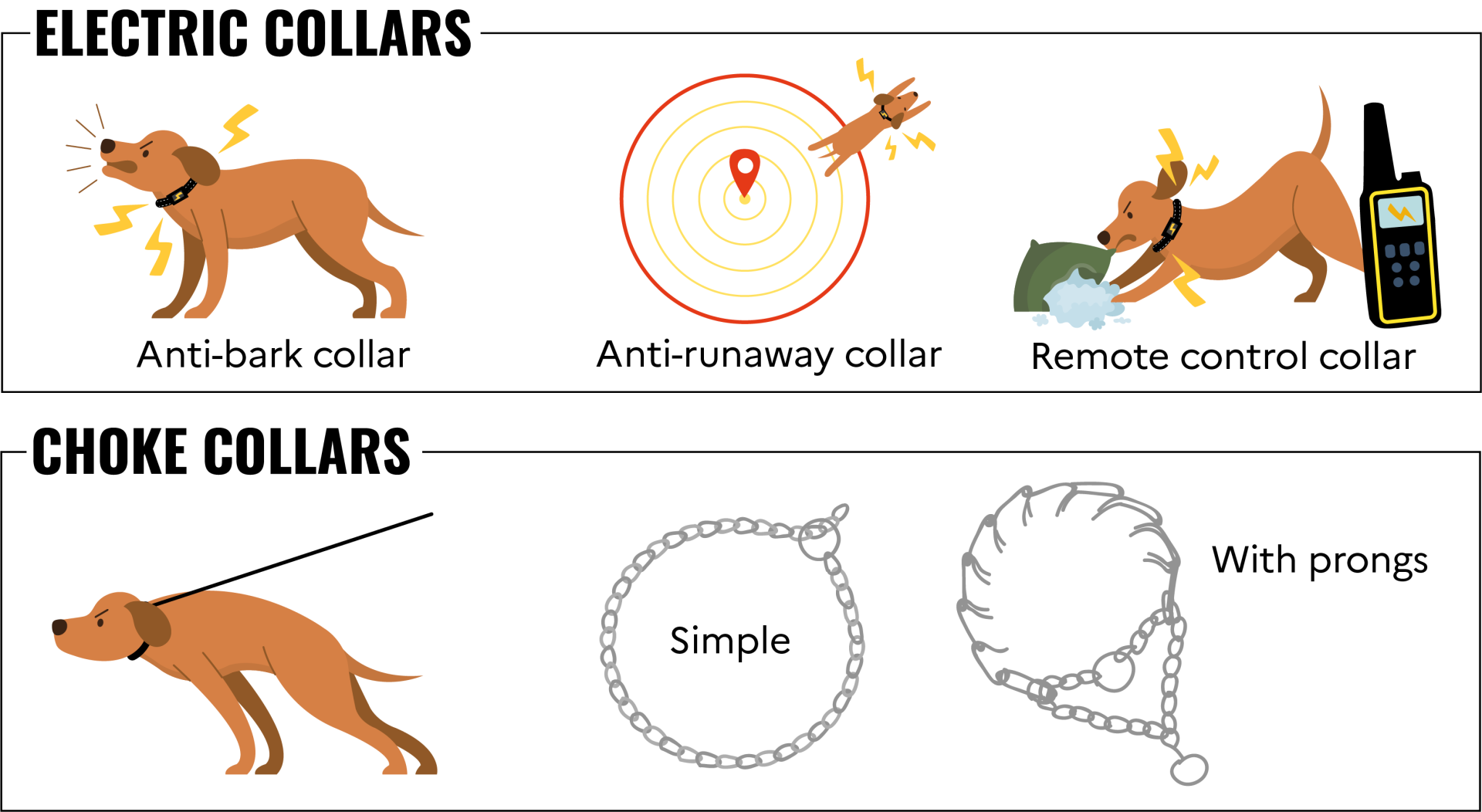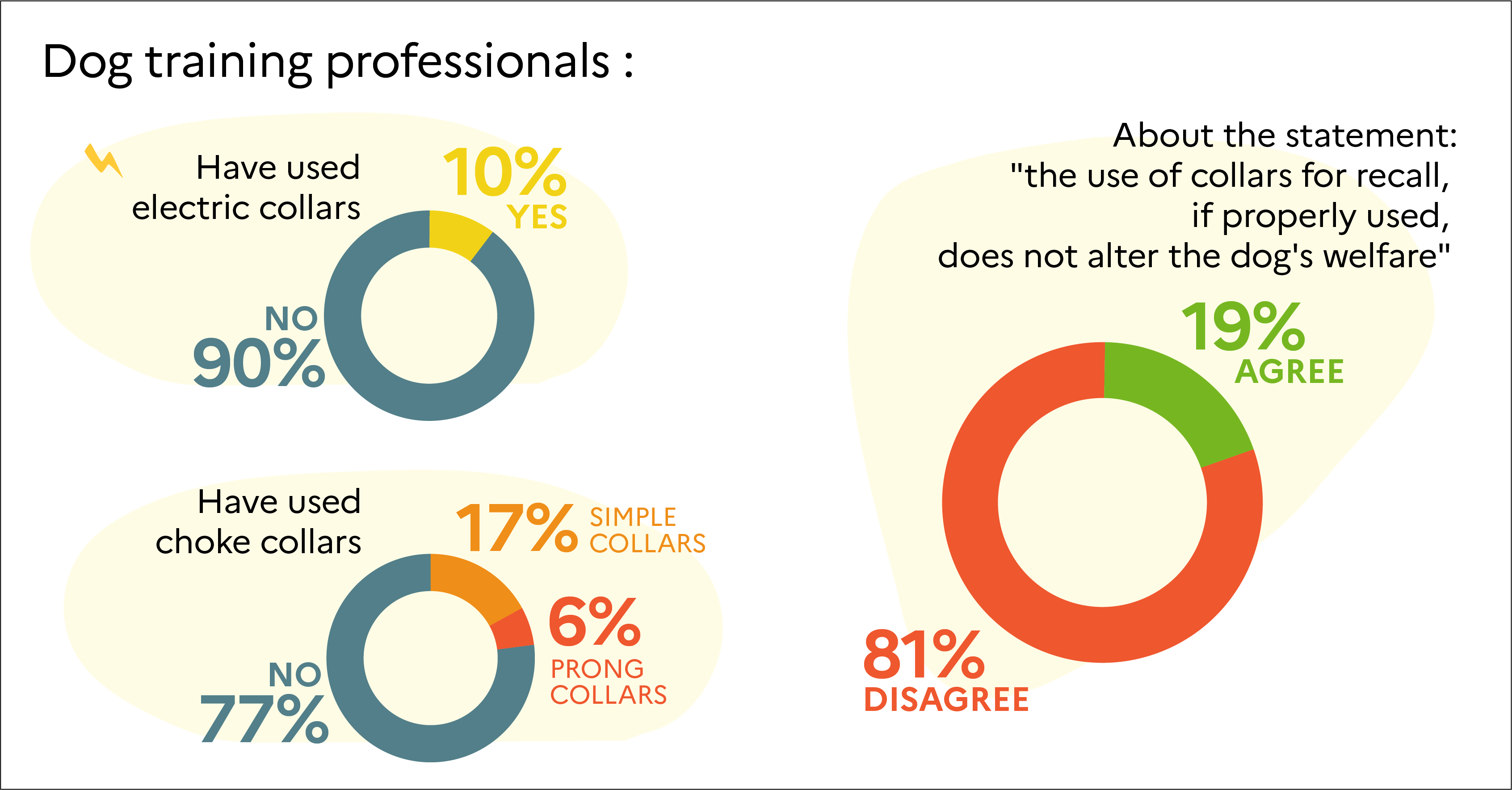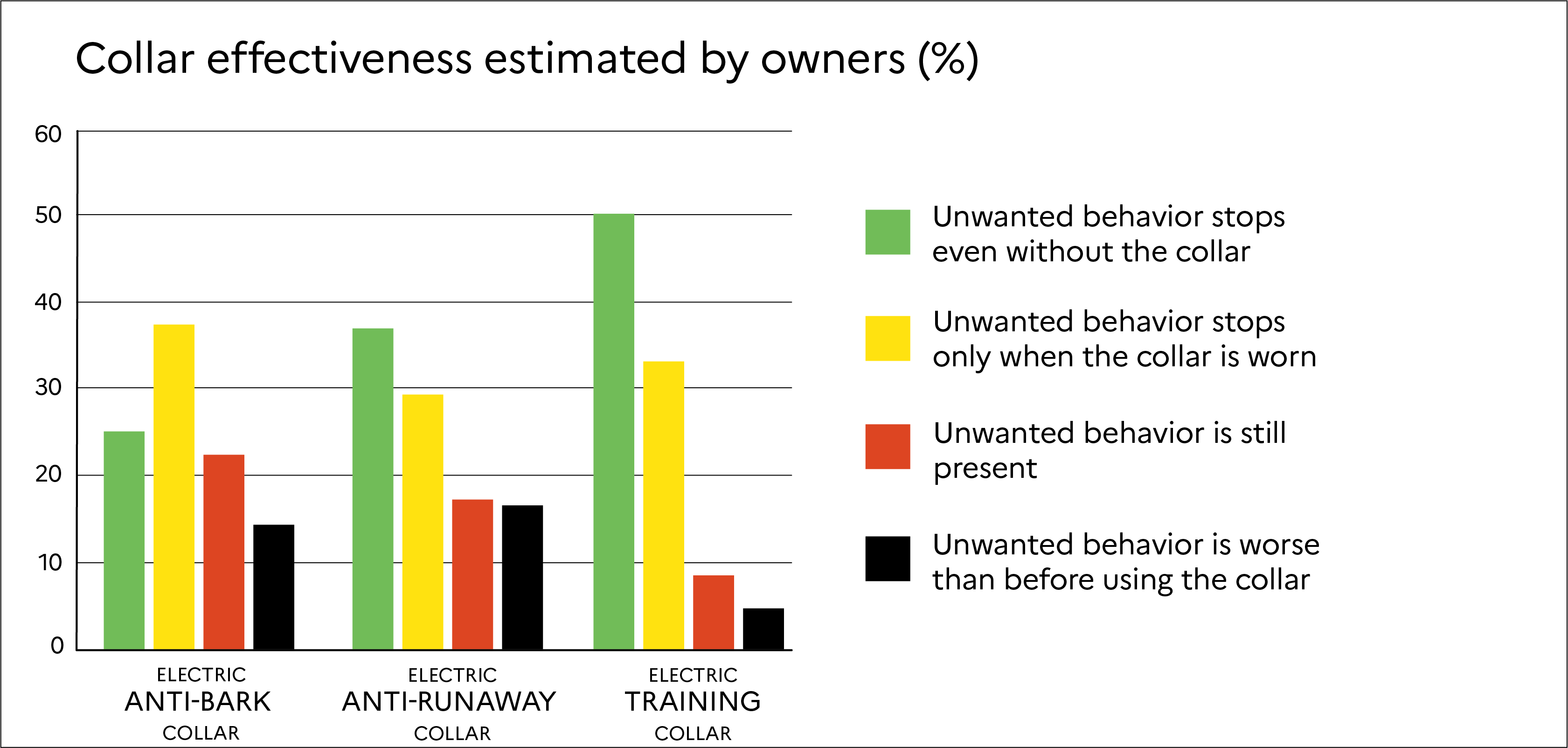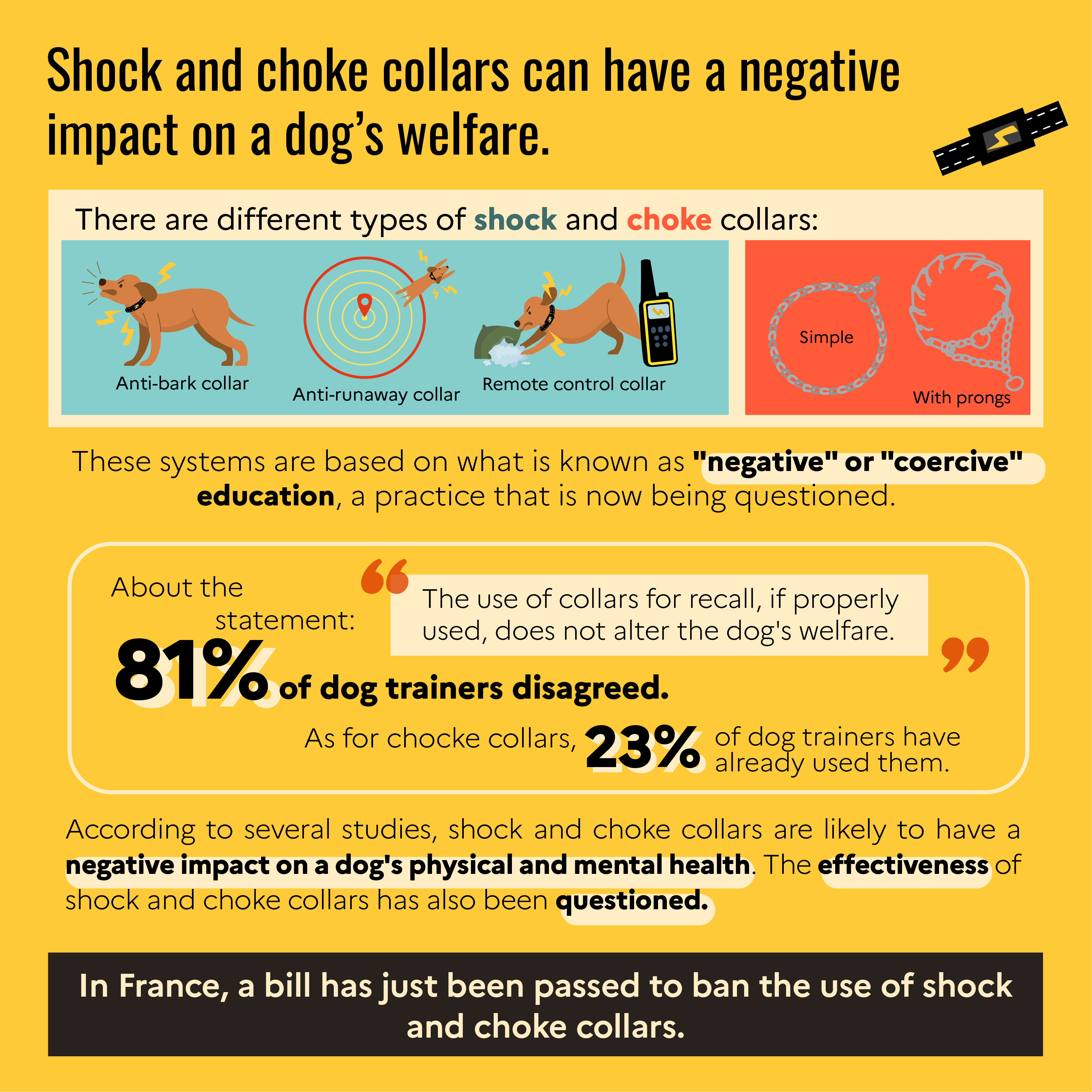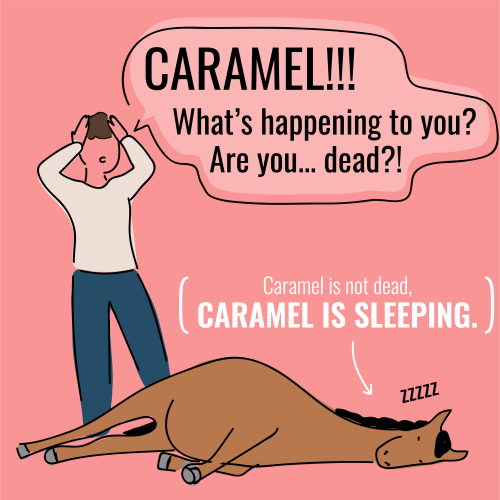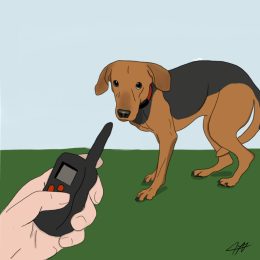

FALSE
These devices can have a negative impact on dogs’ physical and psychological welfare, and are not more effective than “positive” methods.
Keep in mind
- Shock and choke collars are punitive tools designed to suppress a behavior in a dog deemed undesirable by its owner
- These collars have a negative impact on the dog's physical and mental health
- Today, the effectiveness of these devices is debated in relation to reward-based education.
Choke and shock collars are sometimes used to train pets. However, recent studies and veterinary practice have shown that these devices can have a negative impact on dogs’ welfare. Moreover, their effectiveness, and more generally the effectiveness of so-called “negative” or “coercive” training methods, is now being questioned.
Knowing the impact of these devices on animal welfare – as well as their potential usefulness – is all the more important as the law currently prohibits training methods likely to induce unnecessary injury or suffering for the animal. A bill has just been passed by the French National Assembly to ban the use of choke and shock collars.
Alongside the bibliography, Elodie Contamin, veterinary behaviorist, shares her experience in the field and her views on choke and shock collars.
Choke, shock and prong collars: what is this all about?
Electric or shock collars are tools that send electrical impulses to the animal when it performs behavior deemed inappropriate. The most commonly used collars are generally of three types:
- Collars that are triggered remotely by the owner using a remote control,
- Anti-bark collars that automatically send an electrical impulse when the dog barks,
- Anti-runaway collars that automatically send an electrical impulse when the dog crosses a certain geographical zone.
Choke collars are generally used to prevent an animal from pulling too hard on the leash and to teach it to heel. They work on the same principle as a slipknot: the more the animal pulls, the tighter the collar, creating a choke that is supposed to make it react and reduce its pull on the leash. There are generally two types of choke collars:
- Simple collars, often consisting of a chain,
- Prong collars: the prongs are directed towards the animal’s body. In this case, in addition to the strangulation effect, the pressure of the points on skin increases with the pull.
These tools for suppressing undesirable behavior are based on what is known as “operant conditioning“. This learning method, developed in particular by psychologist B. F. Skinner, involves a stimulus, either positive or aversive, in response to an animal’s behavior, in order to condition it. The stimulus can be applied according to a reinforcement or punishment principle, thus making the behavior’s expression more likely (for reinforcement) or less likely (for punishment).
Shock and choke collars are based on two techniques in particular:
- Positive punishment: application of an aversive stimulus (the electrical impulse) to stop behavior deemed inappropriate. The term “positive” is used here because a stimulus is added. If we were to remove a stimulus (e.g. take away a dog’s game to punish it), we’d call it negative punishment.
- Negative reinforcement: application of an aversive stimulus which is removed once the desired behavior has been obtained. For example: in the case of a choke collar, the dog’s strangulation (aversive stimulus) is maintained until it stops pulling on the leash.
In all cases, we can see that the use of shock and choke collars refers to an education method based on the application of aversive stimuli and on coercion, rather than cooperation. This is why they fall into the category of “negative” or “coercive” training practices, as opposed to “positive” training practices based on positive stimuli and rewards.
The aim of positive education is to make learning fun for the animal. This makes learning more pleasant and easier, and creates a bond and cooperation between human and animal.
ELODIE CONTAMIN, VETERINARY BEHAVIORIST

What proportion of owners use these devices?
According to a 2018 study, in France, 26% of owners surveyed said they had used an electric collar on their dog[1]. Furthermore, according to a 2022 report by the Centre national de référence pour le bien-être animal (CNR BEA), while most of the surveyed dog training professionals (81%) said they disagreed with the idea that “the use of collars (electric, static or citronella) for recall, if properly used, does not alter the dog’s welfare“, just under 19% nevertheless remained in agreement with the idea that this type of collar had no impact on the dog’s welfare. In addition, while around 90% of dog trainers said they never used electric or static collars, 10% of trainers said they did. Finally, just under 6% said they used prong collars, and this figure rises to around 17% for choke collars. In all, nearly a quarter of surveyed professionals said they used a choke collar, whether simple or with prongs[2].
Although the use of electric collars and choke collars seems marginal among owners and dog training professionals, the fact remains that some of them still use them. In regular use, the latter do not appear to consider the use of shock and choke collars as likely to inflict unnecessary injury or suffering upon dogs, as required by law[3].
However, I’m seeing a reduction in the number of people who have used this type of device before coming to see me. I think people are becoming more aware.
ELODIE CONTAMIN, VETERINARY BEHAVIORIST

What are the effects of using such collars on your pet?
Is the use of an electric or choke collar likely to have a negative impact on your dog’s physical and psychological health?
Possible effects of shock and choke collars collars on a dog's physical health
According to the Association Française des Vétérinaires pour Animaux de Compagnie (AFVAC), in nearly 10% of cases, electric collars lead to “spectacular physical consequences, up to and including burns with skin necrosis” »[4]. AFVAC also notes that these lesions can appear after just a few shocks (depending on air humidity and the dog’s skin) and are not necessarily the result of frequent use. Furthermore, according to one study, dogs subjected to electric impulses frequently show signs of pain (vocalization, low tail, etc.)[5]
As far as choke collars are concerned, veterinary practice has shown that they are likely to have various clinical effects: hematomas, tracheal deformation, and so on. In addition, pressure exerted on the nape of the neck tends to increase the dog’s intraocular pressure, potentially causing long-term eye damage. Dogs with thin corneas or glaucoma are particularly likely to be at risk[6]. Although few scientific studies seem to have been published on choke collars, we can mention a case study published in 2013. It reports on a German Shepherd that, as a result of the strangulation caused by its choke collar, had to be euthanized following cerebral edema, certainly caused by the compression of blood vessels preventing proper irrigation of its brain[7].
In some dog clubs, customers have reported to me a really problematic practice: dogs are hung by their leash with their legs no longer touching the ground. In addition to the strangulation and pain induced by the collar, this can also lead to cervical lesions (vertebral displacement, herniated discs), which I have observed in my own practice. This is real animal abuse.
ELODIE CONTAMIN, VETERINARY BEHAVIORIST

Electric and choke collars can therefore have a negative impact on a dog’s physical health, causing various types of injury.
Possible effects of shock collars and coercive methods on a dog's mental health
Furthermore, it seems that the use of electric collars tends to increase the animal’s stress, as shown by physiological markers (increased heart rate and salivary cortisol, all the more so as the discharge is unpredictable from the dog’s point of view)[8] and psychological markers (stress behaviors)[9]. These behavioral signs of stress can occur even outside the training context[10]. More generally, in the context of negative (or “coercive”) training practices based on aversive stimuli, dogs tend to show more physical signs of stress[11].
How effective are electric collars and coercive methods?
As we’ve seen, in France in 2018, a sizeable proportion of dog owners still seem to use electric collars. Among them, 58% recommend their use. What’s more, 51% of users of electric training collars with remote control and 25% of users of anti-bark collars said they were effective[12].
However, several studies tend to call their effectiveness into question. For example, a 2020 study on 63 dogs showed that the use of electric collars, even by professionals, was no more effective than positive training, and led to no less disobedience[13]. Moreover, electric shocks tend to be ineffective when dogs are highly motivated to perform a behavior (e.g., in the case of aggression)[14]. One study even showed a higher risk of runaways in dogs fitted with an electric anti-runaway collar than in those with a conventional fence[15]. According to the aforementioned 2018 study by Masson et al., 15% of users of an electric anti-runaway collar admitted that the undesirable behavior was still present, and 15% felt that the behavior was even worse than before. In the case of anti-bark collars, a total of 35% recognized either the failure of the device, or behavioral deterioration. In the case of electric training collars, just over 30% of owners admitted that the undesirable behavior reappeared when the dog was not wearing the collar.
Furthermore, the intensity of the discharge required to stop inappropriate behavior is difficult to estimate. Indeed, there is a risk of increasing the negative effects listed above if the impulse is too strong, or a risk of habituation if the impulse is too weak. In the latter case, this means that the dog becomes accustomed to the electrical impulse, which no longer has any effect on it.
The dog is also likely to assimilate the electric shock to all stimuli present at the moment of discharge, including the owner or trainer[16]. There is even a risk of aggression being redirected at a present human[17] or animal, subsequently increasing the risk of biting.
Dogs become fearful and emotionally unstable, all the more so because the collar is often used indiscriminately. This instability increases the risk of aggression, as well as the unpredictability of the dog that, because of its constant state of fear, may bite without warning.
ELODIE CONTAMIN, VETERINARY BEHAVIORIST

To our knowledge, the effectiveness of choke collars has not been specifically studied, but their use is part of so-called “negative” or “coercive” education – the effectiveness of which is debated among researchers. Indeed, it appears that the use of negative training tends to diminish the quality of the human-dog relationship, the latter being more likely to show fear signals in the presence of its owner, whereas a dog trained with positive reinforcement will tend to be more attentive to its owner[18]. One study also showed that punitive methods were less effective than positive methods (with rewards) for learning certain tasks, such as letting go/giving an object or heeling. In the same study, owners who used punitive methods, including those using a combination of punishment and reward, reported more behavioral problems with their dogs than those using only positive methods[19]. Finally, the use of coercive methods is likely to increase the risk of dog aggression towards humans[20].
In conclusion
It appears like the use of shock and choke collars not only can have a negative impact on dogs’ mental and physical health, but may also be ineffective. This ineffectiveness may lead owners to increase shock or choke intensity, which is likely to have a major impact on the dog’s state of health. Finally, the potential deterioration in the dog’s behavior (aggressiveness, unpredictability, deterioration in the human-dog relationship) may lead to its abandonment, or euthanasia (in the case of aggressiveness).
Today, many professionals are in favor of banning this type of device. AFVAC issued a note in November 2022 on the physical and psychological impacts of using so-called “training” collars (shock, choke and prong collars), and many associations are campaigning to ban their use. This is particularly true of the Brigitte Bardot Foundation, which strongly supported the bill to ban their use.
In short
Interview of Elodie Contamin, veterinary behaviorist

To round off our discussion, here’s an interview with behaviorist veterinarian Elodie Contamin, who shares her views on shock and choke collars
Do you often come across dog owners who use electric collars or choke collars?
It’s not systematic, but it happens. And when it does, there’s always damage done to the dogs’ behavior. Dogs become fearful and emotionally unstable, all the more so because the collar is often used indiscriminately. This instability increases the risk of aggression, as well as unpredictability, because the dog, in a constant state of fear, can bite without warning. I’ve also dealt with two owners who used an electric collar and were bitten by their dog. In this particular case, the dog was so apprehensive about wearing the collar that it attacked its owner when he tried to put it on. As far as choke collars are concerned, owners who report having used them are few, but they systematically tell me how ineffective the method is for learning to heel.
I’d like to point out, however, that I’m seeing a reduction in the number of people who have used this type of device before coming to see me. I think people are becoming more aware. Many of my clients have come to see me because they were shocked by some of the methods used by certain coercive educators, something I observed much less before. At the same time, I’ve noticed a kind of embarrassment on the part of customers who admit to me that they’ve used an electric collar. This shows that the use of these devices is less taken for granted than it might have been in the past.
Have you observed any clinical signs related to the use of these devices? If so, what are they?
In addition to a generalized state of anxiety, various lesions can be observed on the dogs: burns on dogs wearing electric collars, and deformations of the trachea on those wearing choke collars. In some dog clubs, customers have told me of a practice that poses a real problem: dogs are hung by their leash with their legs no longer touching the ground. In addition to the strangulation and pain induced by the collar, this can also lead to cervical lesions (spinal displacement, herniated discs), which I have observed in my own practice. This is real animal abuse.
What are the alternatives to coercive collars for a dog that runs away or barks inappropriately, for example?
As far as I’m concerned, a dog that runs away is a dog that’s bored at home, either because it hasn’t been outside enough, or because it hasn’t been stimulated enough. Some breeds, however, are more prone to running away, such as pack dogs (Husky type) and hunting dogs (Beagle type). These dogs are genetically more independent and need to run, track and sniff. It’s up to the owner to choose the breed that best suits his or her needs. If, despite everything, your dog has a tendency to run away, it’s better to leave it indoors when you’re away, while allowing it to move freely and have the social interaction it needs with you outside. A dog alone in a garden is not necessarily happy, especially if it can’t get out and about: in this case, the garden is simply a bigger prison.
As for barking, in my opinion it’s one of the most complicated things to manage, because there’s also a conditioning effect on the human, who thinks he’s stopping the barking and interacts with his dog, actually reinforcing its behavior. In this case, the owner needs to be rigorous and regular, and this is sometimes difficult to achieve. Then, once again, you have to take into account the genetic factor: beagles, for example, are dogs genetically programmed to bark when they see prey, as a warning. You really need to be aware of all this when you choose a dog. A dog that barks may be a bored dog, in need of exercise and occupation, that doesn’t cope well with its owner’s absences, but it may also be a dog that alerts, because it has been genetically programmed to do so, or a dog that has learned to do so to get attention. The problem really is managing your dog’s needs, its way of communicating, what you’re able to tolerate and the level of commitment you’re capable of.
How do you define positive education?
The aim of positive education is to make learning fun for the animal. This makes learning more pleasant and easier, and creates a bond and cooperation between human and animal. Positive education does not mean permissive education. In positive training, you can put constraints on your dog, but the framework is set in a positive way, in the form of rewards: for example, you may allow your dog to lie on your sofa, but only after asking for permission (for example, by siting); you can teach your dog to be manipulated, even if this isn’t initially a pleasant exercise for it. Some dogs will be more difficult than others to teach. In all cases, owners must be committed and try to understand how their dog works, how it communicates, what motivates it, and so on. Positive training is training that takes the dog’s welfare into account, whereas coercive methods are undeniably learning through fear.
[1] Masson S., Nigron I., Gaultier E., 2018. Questionnaire survey on the use of different e-collar types in France in everyday life with a view to providing recommendations for possible future regulations, Journal of Veterinary Behavior 26. https://doi.org/10.1016/j.jveb.2018.05.004
[2] « Rapport du CNR BEA sur les pratiques d’éducation canine et leurs impacts sur le bien-être des chiens » available here: https://www.cnr-bea.fr/wp-content/uploads/2022/09/Rapport-CNR-BEA-Pratiques-et-outils-déducation-canine.pdf
[3] To find out more about French legislation concerning the use of these collars, please consult our article: https://chaire-bea.vetagro-sup.fr/decryptage-de-la-proposition-de-loi-visant-a-interdire-les-colliers-electriques-et-etrangleurs/
[4] Furthermore, according to Masson et al. (2018), based on the results of a questionnaire sent to owners, anti-bark collars create the most burns.
[5] Schilder, M.B.H., Van Der Borg, J.A.M., 2004. Training dogs with help of the shock collar: Short and long term behavioural effects. Applied Animal Behaviour Science 85. https://doi.org/10.1016/j.applanim.2003.10.004
[6] Pauli A.M., Bentley E., Diehl K.A., Miller P.E., 2006. Effects of the application of neck pressure by a collar or harness on intraocular pressure in dogs. Journal of the American Animal Hospital Association 42(3). https://doi.org/10.5326/0420207
[7] Grohmann K., Dickomeit M. J., Schmidt M. J., Kramer M., 2013.Severe brain damage after punitive training technique with a choke chain collar in a German shepherd dog, Journal of Veterinary Behavior 8 (3). https://doi.org/10.1016/j.jveb.2013.01.002
[8] Schalke E, Stichnoth J., Ott S., Jones-Baade R., 2007. Clinical signs caused by the use of electric training collars on dogs in everyday life situations. Applied Animal Behaviour Science 105(4), https://doi.org/10.1016/j.applanim.2006.11.002
[9] Schilder et al., 2004.
[10] Schilder et al., 2004.
[11] See Ziv, G., 2017. The effects of using aversive training methods in dogs—A review. Journal of Veterinary Behavior: Clinical Applications and Research 19, https://doi.org/10.1016/j.jveb.2017.02.004
[12] Masson et al., 2018. It’s important to specify that this proportion is measured by a questionnaire based on the subjective perception of dog owners, and not on the opinion of a professional expert in canine signals and behavior.
[13] China L., Mills D.S., Cooper J.J., 2020. Efficacy of Dog Training With and Without Remote Electronic Collars vs. a Focus on Positive Reinforcement. Frontiers in Veterinary Science 7. https://doi.org/10.3389/fvets.2020.00508
[14] Polsky, R.H., 2000. Can aggression in dogs be elicited through the use of electronic pet containment systems? Journal of Applied Animal Welfare Science 3, https://doi.org/10.1207/S15327604JAWS0304_6
[15] Starinsky, N.S., Lord, L.K., Herron, M.E., 2017. Escape rates and biting histories of dogs confined to their owner’s property through the use of various containment methods. Journal of the American Veterinary Medical Association 250 (3). https://doi.org/10.2460/javma.250.3.297
[16] Schilder et al., 2004.
[17] Polsky, 2000.
[18] Deldalle, S., Gaunet, F., 2014. Effects of 2 training methods on stress-related behaviors of the dog (Canis familiaris) and on the dog-owner relationship. Journal of Veterinary Behavior: Clinical Applications and Research 9 (2).https://doi.org/10.1016/j.jveb.2013.11.004
[19] Hiby, E. F., Rooney, N. J., Bradshaw, J. W. S. 2004. Dog training methods: their use, effectiveness and interaction with behaviour and welfare. Animal Welfare 13(1). https://doi.org/10.1017/S0962728600026683
[20] Herron M.E., Shofer F.S., Reisner I.R., 2009. Survey of the use and outcome of confrontational and non-confrontational training methods in client-owned dogs showing undesired behaviors. Applied Animal Behaviour Science 117. https://doi.org/10.1016/j.applanim.2008.12.011
Keep in mind
- Shock and choke collars are punitive tools designed to suppress a behavior in a dog deemed undesirable by its owner
- These collars have a negative impact on the dog's physical and mental health
- Today, the effectiveness of these devices is debated in relation to reward-based education.
Key Figure
of dog trainers believe that an electric collar does not affect a dog’s welfare if used properly.

We have dogs that become fearful and emotionally unstable, because the collar is often used in the wrong way. This instability increases the risk of aggression, as well as the unpredictability of the dog who, because of its constant state of fear, may bite without warning.

ELODIE CONTAMIN, veterinary behaviorist

